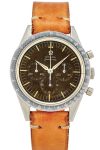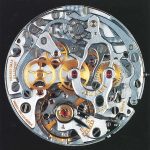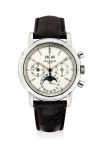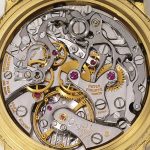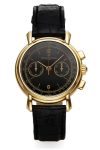Audemars Piguet
The Lemania CH 27: To the Moon and Back
Lemania was not established, as one might suppose, on the shores of Lac Léman. Instead, it was located further north, in the village of L’Orient, in the Vaudoise Siberia, just to the east of where the Orbe empties its chill flow into Lac du Joux.
With economic troubles looming, Omega joined forces with Tissot in February 1930, allowing them to pool their technical strengths and their markets. Two years later, Lemania made it a triumvirate, gaining a seat on the board of Société Suisse pour l’Industrie Horlogère, or SSIH as the group was known – not to be confused with SIHH. This secured for Lemania the loyalty of one of its oldest customers, and one of the world’s strongest watch brands: in 1936, a half-million Omega watches were in production at any one time in the factory, and over 9 million of the company’s products are reported to have been in current use in that year.
Patek Philippe, Vacheron Constantin, Audemars Piguet – each of the “Big Three” has been seduced by the goodness of the Lemania Calibre CH27, whether under the auspices of SSIH, Groupe Horloger Breguet, or indeed, Manufacture Breguet, as it has now become under the Swatch umbrella. The point is that the movement enjoys a history of considerable gravity, having survived one industrial onslaught after another – in fact, not just survived but thrived, garnering the respect of the industry’s leading producers.
Two watches that spring to mind from the many Lemania CH27 variants are the Patek Philippe perpetual calendar chronograph ref. 3970, introduced in the mid-1980s, and the Omega Speedmaster from 1957 to 1965. Found in the Speedmaster Professional from 1965 to 1968 it is, therefore, known for powering what we all call the Moon Watch. Each commands fiercely devout armies of collectors, and deservedly so, although their being related by a common calibre is incidental to their adulation by the watch-collecting fraternity. Everything about the value of these watches flows from one source: the authenticity of their heritage.
Watches like the Omega Speedmaster (Calibre 321) and the Patek Philippe 3970 (Calibre CH 27-70 Q) notionally share the same blueprint. One only need hold these two movements side-by-side to see exactly how similar they are… and yet, a lot like the “twins” Arnie Schwarzenegger and Danny de Vito, they could not be more different. There is the perfect conjunction of the functional aspects; both watches are, after all, 12-ligne, three-subdial, double-action chronographs, with their displays in the same places relative to each other, but after this consideration, the pair’s departure begins almost immediately.
On the one hand, we have a very high-grade, hand-finished product made in Geneva, and on the other, we have a sturdy, reliable, expeditionary watch. We naturally expect the metal finishing to be different. But to conclude that beautiful black polishing and bevelled edges is where Patek Philippe’s interventions start and end is utterly to miss the point.
Solid bankings require a fundamentally different structure to the base-plate, and that, in turn, is the foundation on which the whole movement is built. As manifested by Patek Philippe, it was required to be entirely re-manufactured, if not actually supplied in a different format to its relatives. If you are going to re-manufacture something as profound as a base-plate, you wouldn’t stop there, would you? One doesn’t re-build a Lotus chassis from scratch without also attending to the coachwork and upholstery. More on that later.
Working our way clockwise around the movement from the balance, look at how the Patek’s balance spring is freely mounted without an index or curb pins, attached with a kidney-shaped stud holder. See how the escape wheel has a ruby end-stone. The chronograph drive wheel is soundly (and expensively) mounted in its own frame, not cantilevered in mid-air as in the Lemania base calibre. The clutch itself has become a sinuous “s”, pivoted around a proper bearing boss mounted on the drive-wheel cock, whilst it is tensioned by a beautiful coil of hardened steel whose profile perfectly shadows that of the clutch itself. Shall we go on? I think you get the point.
One has to look at the calibre with a degree of insight to realise that it has the same origins as the 321. Perhaps the most obvious clue to their shared parentage is the paths of the three arms of the zero-return hammers and chronograph brake, and the little bird-shaped bridge for the sliding gear that engages the chronograph drive wheel with the minute recorder.
Earlier, we briefly referred to the question of whether the Lemania movement was re-manufactured by Patek Philippe or whether it was supplied in a different format. We can definitely report that among the components that were supplied to Patek, a large proportion were prepared in a special over-size format – you appreciate I’m referring to hundredths of a millimetre here. This was to allow for Patek’s extensive hand-finishing. You can’t properly black polish or grain a steel part that is already “to size”, because then you’d be making it too small. In the case of something like a spring, this is utterly verboten, because the functional integrity flows from its size, which in turn flows from how much it’s been hand-finished and so on.
Very different, yet the same. The parts shaded green can help you spot the underlying Lemania calibre, and are the same in the Patek (above) and the Omega (below). Many parts in the Patek version (for example, the ones highlighted in magenta) have been completely redesigned, and are nothing like the original base calibre.
Another aspect of the discussion reverts once more to the Geneva Seal. Without putting too fine a point on it, a watch can only get the Geneva Seal if it was made in Geneva. If the movement was supplied more-or-less ready to go by Lemania, which is based in a different town in a different canton, it wouldn’t qualify for the venerated Poinçon. This would imply substantial amounts of re-manufacture within the “city walls” of Geneva, one German source citing that effectively 60 per cent of this calibre was re-built in-house by Patek. Indeed, Patek itself describes the episode thusly: “In 1986, Patek Philippe opened a new chapter in its legacy of chronographs by presenting the famous manually wound calibre CH27-70 based on a Nouvelle Lemania movement blank produced exclusively for Patek Philippe and completely reworked in the manufacture.”
We’ve deliberately not discussed the many subtle variants of the Lemania CH27. We prefer to leave the list-making to others, although there is the argument that the guaranteed way to determine whether you have every possible item listed is to publish it, whereupon three more will immediately be brought to light. What interests us is not whether this or that variant had a 30-minute or a 15-minute recorder, or a pulsometric or tachymetric dial, but rather the industrial processes that gave rise to them, and the relationships that were forged as a result of such variety.
Certainly, in terms of industrial processes, there are in fact few examples in horology where complexity and fineness are quite as acute as in a chronograph. And yet chronographs seem almost pedestrian; which of us would rank a chronograph beside a tourbillon or a repeater? Yet, it is absolutely the equal of these complications, and more. Perhaps it’s because companies like Lemania got so good at it that chronographs have come to be seen as almost commonplace.
The “goodness” of complications like minute repeaters is very much a matter of subjective judgement. Even things like perpetual calendars have a degree of acceptable variability – would you really notice if one of the displays on a calendar took a half-second longer to flick over than the other? But not so a chronograph. All its functions have to operate sensitively and perfectly, every single time. Variations in its display by even a few hundredths of a second will be glaringly obvious. Springs must whip instantaneously, hammers have to percuss to the same positions without fail, gears with teeth no further apart than three human hairs’ thickness must engage consistently time and time again.
Speaking about their sophistication, Berhard Humbert, Professor of Special Chronograph courses in Biel, wrote: “Technical progress has not by-passed the manufacture of levers and springs for chronographs” and goes on to conclude that the specialist chronograph makers (of which Lemania was one of the foremost) produced a quality product combining nicely finished parts with precision and “they have a right to the gratitude of the horological world”. Enough said.
Says Master Watchmaker Peter Roberts: “By the 1940s, there were quite a number of well-developed chronograph movements available. Developed jointly by Lemania and Omega, working together on a project called ‘27 CHRO C12’ to develop a 27mm diameter chronograph with a 12-hour register, Albert Piguet and Jacques Reymond produced a surprisingly small and slim hour-recording chronograph. Their calibre 2310 was a new design, though executed in the classic manner of the two-dimensional column wheel layout. By ‘two-dimensional’, I mean that all chronograph adjustments and positionings are made in one plane: the horizontal.”
Called Calibre 321 by Omega, the Calibre 2310 was a column wheel design with a screwed balance oscillating at 18,000bph. It has a distinctive “wishbone”-shaped bridge, making it instantly recognisable to enthusiasts. The cam-switching Lemania 1872 family replaced the 2310 for most applications beginning in 1968.
Among the interesting points to the movement were, Roberts cites the multi-piece pivoted minute recorder jumper, “an expensive to manufacture addition.” The calibre used an overcoil balance spring with all-enveloping extended curb pins for enhanced balance spring shock protection. All steel chronograph parts were “nicely machined from heavy gauge material.” A constantly friction-loaded hour recorder mechanism which releases on starting the chronograph helped to balance the torque loads on the movement. But, Roberts notes: “A rather odd rocking bar hammer release lever was a slightly weak point but still remains to this day, and is usually retained by other users of the movement.”
As collectors, and as those who advise collectors, we find it gratifying that the scope of Lemania’s fascinating Calibre CH27 is not heavily biased toward one end of the price scale. We believe that every collection ought to have at least one representation of this venerable movement. This could be something as easy to locate as an early Omega Speedmaster Professional, which in fair condition sells from around £3,500 upwards.
Or maybe a Patek Philippe split-seconds chronograph ref. 5004 is more your taste? Don’t wait for change from £2.6million for the titanium Only Watch special edition. In between, you might pick up a very tasty 1990s Vacheron Constantin Les Historiques for around the £12,000 mark, or even an Audemars Piguet Jules Audemars Tourbillon Chronograph (if the name isn’t succinct enough, try the model reference: 26010OR.OO.D088CR.01), which by comparison with the 5004T seems like jolly good value at £120,000.
Roberts concurs: “This movement was used by some of the best manufacturers and movement enhancers in the business. Enhancements included column wheel caps, chronograph drive wheels mounted between pivoted bridges, extra jewels or end-stones, free-sprung balance wheels and some glorious hand-finishing.
“Of course, none of this makes the movement function more effectively. But when called upon for its finest and greatest task – the trip to the moon – the Lemania movement went along in its pure and unenhanced form.”




